By 2016, it is evident the FAX machine has peaked. Sure, you still see a few. There are even services that will let you send and receive FAXes via Internet–which could mean no FAX machine was involved at all. But looking back, you have to wonder where it all started. Most people had never seen a FAX machine until the late 1960s or early 1970s. It was 1980 before there was a standard. Some, like hams and weather service employees, were using them even earlier. But would it surprise you to know that the first experimental FAX machine appeared in 1843?
Wait a minute. Bell didn’t even build a telephone until 1875 (the patent issued in 1876). Turns out the first FAX machines didn’t work with a phone. They worked over a telegraph wire.
Bain’s Pendulums
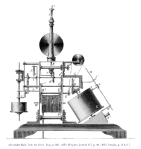 Alexander Bain (not Bell) was a Scotsman who developed an electric clock and a printer that was similar to a needle telegraph. The clocks used pendulums, and so did his FAX-like system (see right). Metal pins on a cylinder and electric probes sensed an insulating image mask and sent signals down a few wires. On the other end, an electrode reproduced the pattern on chemically treated paper.
Alexander Bain (not Bell) was a Scotsman who developed an electric clock and a printer that was similar to a needle telegraph. The clocks used pendulums, and so did his FAX-like system (see right). Metal pins on a cylinder and electric probes sensed an insulating image mask and sent signals down a few wires. On the other end, an electrode reproduced the pattern on chemically treated paper.
Granted, this isn’t precisely the FAX machine we know. The metal pins and probes required the image to be cut out. However, it has all the components you need: a sensor, and encoder, a decoder, and an output device. Results, however, were poor because operators had to synchronize the clocks on both ends accurately and that was nearly impossible to do.
Inventors hotly contested patents back then. Earlier, Charles Wheatstone discouraged Bain from continuing to work on the electric clock, but then built one himself and tried to take credit for it. Luckily, Bain had filed for a patent anyway and wound up winning the princely sum of £10,000 (quite a bankroll in the 1800’s) from Wheatstone in a court judgment. However, the patent system wasn’t as kind to Bain in 1850. Another inventor, Frederick Bakewell, preempted Bain’s.
Bakewell’s Cylinders
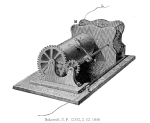 Bakewell demonstrated his new “image telegraph” at the 1851 World’s Fair. Instead of pendulums, Bakewell used cylinders covered with foil. Insulating ink drew the pattern that a metal stylus could sense. The cylinder was somewhat easier to synchronize, but it was still a bit of a problem to get everything perfectly aligned, and the system (see left) never saw commercial service.
Bakewell demonstrated his new “image telegraph” at the 1851 World’s Fair. Instead of pendulums, Bakewell used cylinders covered with foil. Insulating ink drew the pattern that a metal stylus could sense. The cylinder was somewhat easier to synchronize, but it was still a bit of a problem to get everything perfectly aligned, and the system (see left) never saw commercial service.
A commercially viable system had to wait until 1861. That was the year an Italian priest developed the Pantelegraph. It was a far cry from a modern FAX machine, but it was the first machine that was more than a demonstration device.
Pantelegraph
The Pantelegraph, developed by Giovanni Caselli, could transmit an image of about 6 inches by 4 inches. It also used a pendulum with a magnet to synchronize the transmitter and receiver. For accuracy, this required an 18-pound weight mounted on a frame over six feet high! This wasn’t a portable FAX machine.
It wasn’t that fast either. A 4-inch long paper strip about 1 inch wide took over a minute and half to send. That band might contain about 25 handwritten words. In 1860 Napoleon III saw the device and arranged for Caselli to have access to long distance telegraph lines. The signature of composer Gioacchino Rossini appeared 87 miles away.
By 1862, a commercial system between Lyons and Paris was in place with public access in 1863. By 1865, you could also transmit images back to Lyons and to Marseille by 1867. That service operated until 1870. Tsar Nicolas I also set up a system between his palaces in Moscow and St. Petersburg.
Bidwell, Korn and the Telediagraph
By 1881, Shelford Bidwell constructed a “scanning phototelegraph.” This was the first machine to optically scan the material to send, avoiding drawing on foil or some other means of converting the image to an electrically readable format. This isn’t surprising from Bidwell since he was known for experimenting with selenium photocells.
Bidwell sidestepped the synchronization problem by putting the scanning cylinder and the receiving cylinder on the same motor shaft. In that way, the instrument was more of a photocopier than a FAX. However, his article about the device in an 1881 issue of Nature exposed the idea of optical scanning. Bidwell would go on to write another Nature article in 1908 that predicted some of the issues involved in transmitting and receiving what we’d call television.
There were other early machines that all worked without optical scanning. Inventor Ernest A. Hummel’s Telediagraph dates from 1898. In this system, an 8-inch by 6-inch piece of foil was painted with an insulating ink made from thin shellac. The foil was on a drum and at the end of each revolution, a synchronization signal causes each drum to move 1/56th of an inch to the left. Several newspapers, including the New York Herald, the Chicago Times Herald, the St. Louis Republic, and the Philadelphia Inquirer used these machines. An article in a 1900 Pearson’s Magazine described this machine and included some pictures of it in operation.
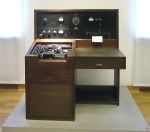 It would be 1906 before Arthur Korn used photocells in the Bildetelegraph (see right). This machine was popular and used a Nernst lamp–a form of incandescent lamp with a ceramic filament that would operate in air. Korn transmitted a picture of Crown Prince William over 1,000 miles. A Bildetegraph was famous for sending photos of a wanted person from Paris to London in 1908.
It would be 1906 before Arthur Korn used photocells in the Bildetelegraph (see right). This machine was popular and used a Nernst lamp–a form of incandescent lamp with a ceramic filament that would operate in air. Korn transmitted a picture of Crown Prince William over 1,000 miles. A Bildetegraph was famous for sending photos of a wanted person from Paris to London in 1908.
The Belinograph and Elisha Gray
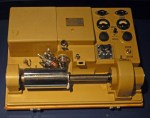 In 1907 Édouard Belin created the Belinograph (lucky for us this naming convention fell out of favor, or people would have a Jobsophone, I suppose). You can see a later example of the machine to the left. It used optical scanning and eventually became known as Wirephoto.
In 1907 Édouard Belin created the Belinograph (lucky for us this naming convention fell out of favor, or people would have a Jobsophone, I suppose). You can see a later example of the machine to the left. It used optical scanning and eventually became known as Wirephoto.
The machine was greatly improved by Vladimir Zworykin (who worked for Western Electric) in 1929. Zworykin’s improved machine could send a full page in only one minute. Machines like this carried news photos around the country to newspapers on behalf of agencies like Associated Press and International News Photos. In fact, there was even a false start to sending news to homes via FAX.
It is amazing that Elisha Gray isn’t more of a household name. He may have developed the telephone before Bell, although that’s a subject of hot debate. He co-founded Western Electric and was one of the founders of Graybar. His invention of the “Musical Telegraph” may make him one of the many fathers of the modern music synthesizer.
Gray had over 70 patents, but the one of interest related to FAX was for the Telautograph. The Gray National Telautograph Company formed in 1888 and was eventually bought by Xerox in the 1990s. As the name might suggest, the Telautograph was made to capture signatures or handwriting. It used potentiometers (say, that sounds familiar) and caused a pen on the receiver to duplicate the motion of the pen in the sender’s hand.
This isn’t much of a traditional FAX machine, although it was useful where a signature was necessary, like banks and hospitals. Some train stations used these machines up until the 1970s, and one can be seen in the 1956 movie Earth vs. The Flying Saucers (which is not a court room drama, if you were wondering).
Wireless FAX and the FAX of Tomorrow
Even though most modern FAX machines used telephone wires, there have been no shortage of radio-based FAX machines, too, starting about 1923. We’ve talked before about Rudolph Hell’s invention, which is sort of a cross between a teletype and a FAX. Then there was the Telefax service which was a cross between telegrams and pizza delivery.
Over time, FAX machines got more complicated. Herbert Ives developed a color FAX machine. By 1964, Xerox introduced Long Distance Xerography–the first thing most of us would recognize as a modern FAX machine. By 1966, the Xerox MagnaFax could connect to a standard phone line and send a letter-size sheet in about six minutes. It would be the 1980’s, though, before the ITU G3 standard made it realistic to send a FAX from one brand of machine to another.
But today, the FAX machine is almost a relic. Almost. There are still a few hold outs, of course. You can also have a computer send or receive a FAX, either with a modem or via the Internet. In many cases, the computer to computer transfer via FAX is unnecessary, but at least it is universal.
What’s next? Maybe 3D scanners and 3D printers will evolve to the point that they become the new FAX machine, transmitting solid objects around the world just like the FAX sent documents. It isn’t quite the Star Trek transporter, but it might still have its uses.
Main image photo: The Radio Historian
Bildtelegraph photo: Jodo CC BY-SA 3.0
Belinograph photo: Sandstein CC BY-SA 3.0,

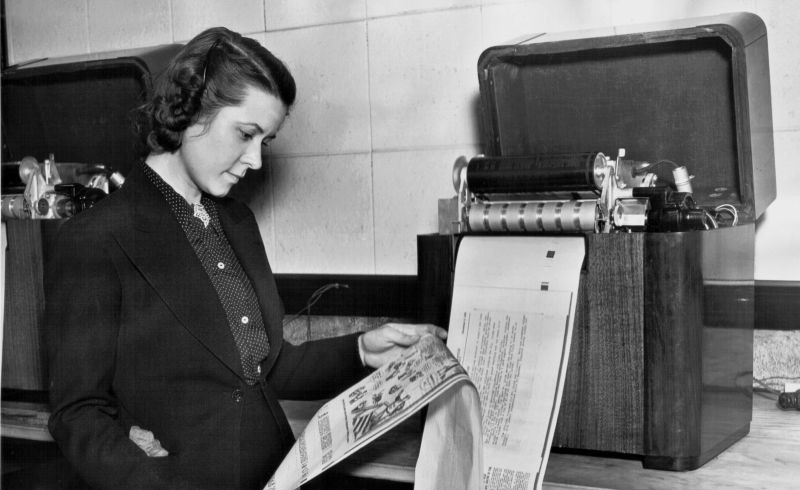














Belinograph – please check the spelling
Bélinographe
Well, that would be French, wouldn’t it?Most english readers would not know what to do with an acute accent, and would pronounce the e at the end as ‘ee’, the result, something like “bee-linogra-fee” would hurt much more francophone ears than the proposed anglicized spelling “Belinograph”, which, incidentally is also supported by Wikipedia: https://en.wikipedia.org/wiki/Wirephoto
If you’ve not seen it, Tim Hunkin’s “secret life of the fax machine”is welll worth a watch : https://www.youtube.com/watch?v=IaCfs5Xb-EI
All of his episodes are worth a watch. They are all on youtube as well
‘Tis a pity that nobody has yet dug out a home recorded tape of The Car episode so people can have a good copy. https://www.youtube.com/watch?v=C4Tp2qpjcgw
Advance to 16:30 and soon you’ll start seeing odd colored bars flash and a field order glitch that gets progressively worse. This is from a bad digital conversion from the original broadcast tapes when the DVD sets were done and nobody checked to ensure all the digitized copies were good.
The tapes would by now be further degraded from age. However, this show was shot on film, which was converted to tape after editing. Tim Hunkin told me via e-mail that it would take $16K to buy the films (didn’t say if that was original or a first generation print/copy).
Kickstarter for a new DVD and Blu-Ray release?
Wow, this specific episode was the very very first show I watched on the Discovery Channel back in the mid 1990s
Ya they’ve been around for awhile before they had their brief moment in the sun as a consumer technology. One of the more important, oldest and widely subscribed radio-based FAX services is WEFAX which broadcasts weather maps. Broadcasting of marine weather charts is today the primary application of radiofax.
WEFAX is still in heavy use today and does not require any subscription. I have a radio that can receive the broadcast from the satellite as it passes over head and software to automatically grab the images.
http://www.wxtoimg.com/
“Subscribed” here in the more general sense as “used regularly”
I regularly keep a watch weather faxes over high frequency (HFFAX) — http://www.nws.noaa.gov/os/marine/rfax.pdf
That website/cloudflare blocks me as it thinks I did something malicious. I just clicked the link on my phone (Firefox on Android)!
I still have to send and receive faxes occassionally for financial and medical records. Direct paper-to-paper faxing has a security advantage in that the file is not sitting on a server or user’s email account.
Though I receive my faxes electronically by email, I never tell the senders that, they don’t like it.
I wonder when the first fax bomb was sent. I can just imagine a well dressed man in a top hat, puffing a pipe in frustration as his new phototelegraph was grinding out 10 tiny pieces of blackened paper an hour.
Off-topic: The word fax seems to have been spuriously capitalised throughout the article, is it the typographic style of the headings being used on key words in the article too?
Years ago, I had the fortune to take a tour of the back rooms of a local museum. One of the really cool things they have hidden away from the public was a radio fax. The transmitter is housed inside a desk designed to look like a roll up desk. The receiver was designed to be mounted on the back of a wagon. The fax was printed on one long continuous roll. My understanding was that the machine still worked, but no one knew enough to operate it.
In any case, I was allowed supervised access to the desk and samples. The technology is astonishing and the quality was superb, though I imagine the length of time to receive the faxes would’ve cause some people to go into fits.
Sadly, I wasn’t there for the radio fax and had to walk away.
Hey… look at that… 2 walls of text without a [continue reading] in two days.
Ya’all really dont take this gig seriously at all, do you?
(Miscommented on Benchoffs VR typewriter post so I felt obliged)
Thank you HAD for listening to my suggestion about an article on the belinograph. Much more complete than what I expected, I’m really glad of it :)
How about “3D FAX”? No, it didn’t transmit anything in 3 dimensions. It transmitted computer files by converting them to full page graphical encoding.
The receive and decode software was free. The version which could do the encoding cost money. What this was useful for (and still would be) was for sending things like spreadsheets and word processing documents to places that didn’t have any sort of internet access or for secure sites where the computers were not connected to a network with external access.
Faster than snail mail of a disk and if the receiving site has a regular FAX machine, the computer doesn’t have to be running. Just take the pile of paper off the output tray and scan it, preferably with an automatic feeder. If the receiving system was a computer with a FAX modem, the software worked better (possibly could do denser encoding) due to a perfect copy of the TIFF images being there for 3D FAX to decode. No low resolution or crooked scans from FAX printouts.
If you wanted to get real odd with this, you could store the printouts of documents and software in a filing cabinet then scan them in to edit and print out the changed versions to file. Offline non-digital storage.
The receive only software can still be found, but the version with encode capability seems to have been pretty well eradicated from the web. Not even the web archive got any of the downloads from the company site.
If a working copy of this cannot be found, there’s a HaD challenge – create the most reliable, most densely encoded way to print all types of computer files, including programs, into FAX compatible images.
There’s already a chap who’s created a way to archive digital files onto paper. Just using black and white dots. I think he gets about 100K per A4 page. Pretty sure it was featured on HAD a few years ago. European bloke, maybe German.
…
Ah, I think this is him… http://ollydbg.de/Paperbak/ , 500K per page, at 600DPI.
Lets not forget the old favorite of transmitting images as ASCII characters. They were doing some of this on old teletype machines.
How could you have missed Hellschreiber?
https://en.wikipedia.org/wiki/Hellschreiber